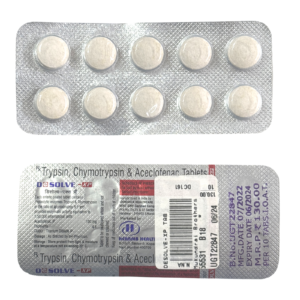PARACETAMOL (ACETAMENOPHEN) + DICLOFENAC + TRYPSIN + CHYMOTRYPSIN
Paracetamol (acetamenophen): Paracetamol, also known as acetaminophen, is a widely used over-the-counter analgesic (painkiller) and antipyretic (fever reducer). It is commonly used for the relief of mild to moderate pain, such as headaches, toothaches, muscle aches, and menstrual cramps. It is also effective in reducing fever.
The mechanism of action for paracetamol is not yet fully understood. It is believed to work by inhibiting the production of prostaglandins in the brain, which are responsible for pain and fever. Unlike non-steroidal anti-inflammatory drugs (NSAIDs), paracetamol does not have anti-inflammatory effects.
The recommended dose of paracetamol for adults is 500-1000 mg every 4-6 hours, up to a maximum of 4,000 mg in a 24-hour period. For children, the dose is weight-based. It is important to follow the recommended dosage to avoid the risk of liver damage.
Paracetamol is generally considered safe when used at recommended doses. However, exceeding the maximum daily dose or taking it for an extended period can lead to liver damage. Symptoms of liver toxicity include nausea, vomiting, abdominal pain, and yellowing of the skin and eyes (jaundice). It is essential to avoid consuming alcohol while taking paracetamol as it increases the risk of liver damage.
Other rare side effects of paracetamol may include allergic reactions, skin rash, and a decrease in the number of blood cells. It can also cause difficulty breathing or wheezing in people with asthma. While paracetamol is generally safe, it is always a good idea to consult a healthcare professional before starting any new medication, especially if you have pre-existing medical conditions or are taking other medications.
Diclofenac: Diclofenac is a nonsteroidal anti-inflammatory drug (NSAID) that is commonly used to relieve pain and inflammation in conditions such as arthritis, osteoarthritis, and rheumatoid arthritis. It belongs to the same class of drugs as ibuprofen and aspirin.
The mechanism of action of diclofenac involves inhibiting the production of prostaglandins, which are responsible for pain and inflammation. It achieves this by blocking the action of the enzyme cyclooxygenase (COX), which is involved in the synthesis of prostaglandins.
Diclofenac is available in multiple formulations, including tablets, capsules, gels, creams, and injections. The dose and dosing frequency may vary depending on the form and indication.
For the relief of pain and inflammation, the usual starting dose for adults is 50 mg orally three times a day. However, the dose may be adjusted based on the severity of the condition and individual response. It is important to follow the prescribed dosage and consult a healthcare professional for specific instructions.
As with any medication, diclofenac can have side effects. Common side effects include stomach upset, nausea, indigestion, headache, dizziness, and constipation. In some cases, diclofenac can cause more serious side effects such as gastrointestinal bleeding, liver damage, kidney problems, heart-related issues, and allergic reactions. It is important to promptly report any unusual or severe side effects to a healthcare professional.
Diclofenac may not be suitable for everyone, especially individuals with a history of stomach ulcers, heart disease, kidney or liver problems, asthma, or allergies to NSAIDs. It can also interact with certain medications, so it is important to inform the healthcare professional about any other medications being taken.
Overall, diclofenac is a commonly used NSAID that effectively reduces pain and inflammation. However, its use should be carefully monitored and prescribed by a healthcare professional to ensure its safety and effectiveness.
Trypsin: Trypsin is a proteolytic enzyme that is used primarily as a topical medication for wound healing. It is derived from bovine (cow) pancreas or porcine (pig) pancreas, and it is available as a powder or ointment.
The main mechanism of action of trypsin is its ability to break down proteins. When applied to a wound, trypsin helps to remove necrotic tissue, slough, and debris, thus promoting wound healing by creating a clean environment for tissue repair. It also has mild anti-inflammatory properties.
The dose of trypsin depends on the specific formulation and the severity of the wound. It is typically applied as a thin layer directly onto the affected area, and the frequency of application can vary from once daily to multiple times per day. It is important to follow the instructions provided by the healthcare provider or the product label.
Common side effects of trypsin include skin irritation, redness, and itching. Some people may also experience an allergic reaction to trypsin, which can manifest as rash, swelling, or difficulty breathing. If any of these side effects occur, it is important to discontinue the use of trypsin and seek medical attention.
It is worth noting that trypsin should not be used in individuals who are allergic to bovine or porcine products. Additionally, it should be used with caution in individuals with known or suspected hypersensitivity to trypsin or any other component of the formulation.
As with any medication, it is always advisable to consult a healthcare professional before using trypsin, particularly if there are any underlying medical conditions or if other medications are being taken.
Chymotrypsin: Chymotrypsin is an enzyme that is naturally produced in the body and is found in the digestive system. However, it can also be extracted and used as a medication. It is primarily used in ophthalmology and is available in the form of eye drops.
Chymotrypsin is used to treat certain conditions in the eye, including corneal ulcers, corneal abrasions, and other traumatic eye injuries. It works by breaking down proteins in the eye, helping to remove debris and eliminate inflammation. This action aids in the healing process and reduces pain associated with these conditions.
The dosage of Chymotrypsin can vary depending on the specific condition being treated. It is typically administered as one or two drops in the affected eye(s), and the frequency of use may range from two to four times per day. It is important to follow the instructions provided by the healthcare professional or the product label.
Common side effects of Chymotrypsin eye drops include temporary stinging or burning sensation in the eyes. Some individuals may experience mild eye irritation, redness, or blurred vision. Allergic reactions are rare but possible, and in such cases, it is important to discontinue the use of Chymotrypsin and seek medical attention.
It is important to note that Chymotrypsin should only be used under the supervision of a healthcare professional. They will determine the appropriate dosage and duration of treatment based on the specific condition being treated and the patient’s medical history.



